2015 Peugeot 208 parking brake
[x] Cancel search: parking brakePage 40 of 341
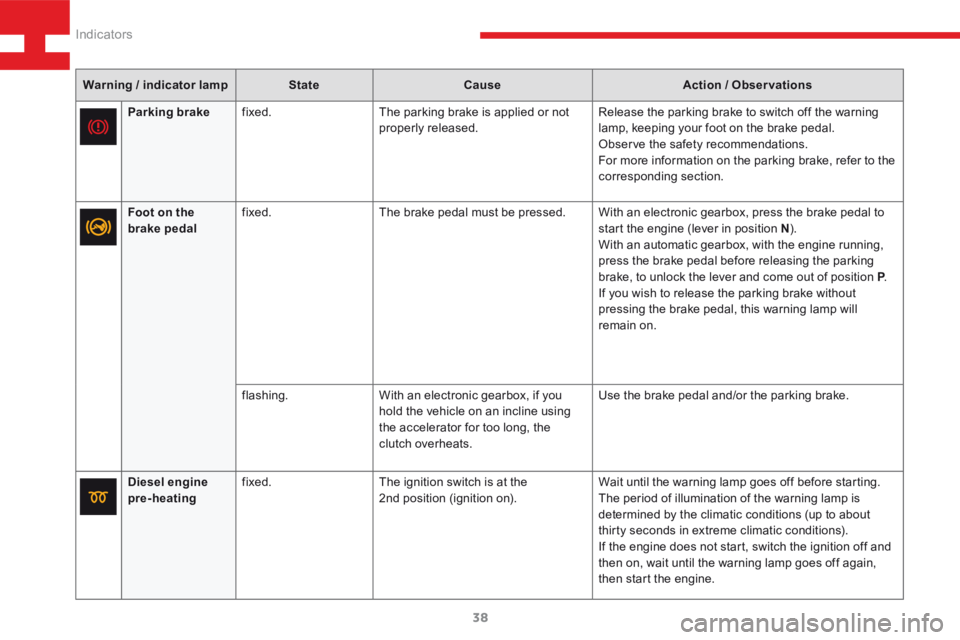
38
208_en_Chap03_Indicateurs_ed01-2015
Warning / indicator lampStateCause Action / Observations
Diesel engine
pre-heating fixed.
The ignition switch is at the
2nd position (ignition on). Wait until the warning lamp goes off before starting.
The period of illumination of the warning lamp is
determined by the climatic conditions (up to about
thirty seconds in extreme climatic conditions).
If the engine does not start, switch the ignition off and
then on, wait until the warning lamp goes off again,
then start the engine.
Parking brake
fixed. The parking brake is applied or not
properly released. Release the parking brake to switch off the warning
lamp, keeping your foot on the brake pedal.
Observe the safety recommendations.
For more information on the parking brake, refer to the
corresponding section.
Foot on the
brake pedal fixed.
The brake pedal must be pressed. With an electronic gearbox, press the brake pedal to
start the engine (lever in position N).
With an automatic gearbox, with the engine running,
press the brake pedal before releasing the parking
brake, to unlock the lever and come out of position P .
If you wish to release the parking brake without
pressing the brake pedal, this warning lamp will
remain on.
flashing. With an electronic gearbox, if you
hold the vehicle on an incline using
the accelerator for too long, the
clutch overheats. Use the brake pedal and/or the parking brake.
Indicators
Page 111 of 341
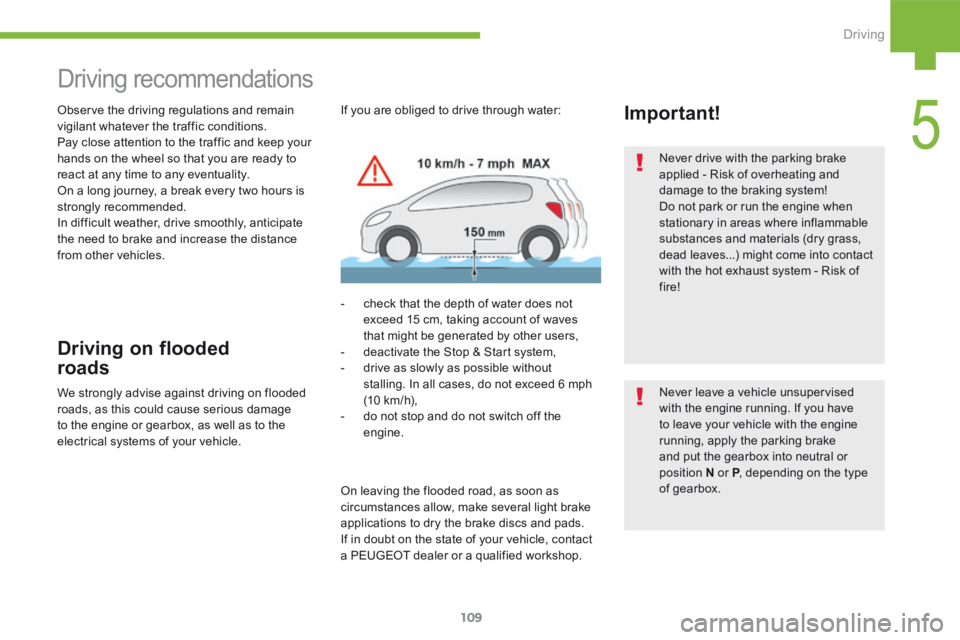
109
208_en_Chap05_conduite_ed01-2015
Never drive with the parking brake
applied - Risk of overheating and
damage to the braking system!
Do not park or run the engine when
stationary in areas where inflammable
substances and materials (dry grass,
dead leaves...) might come into contact
with the hot exhaust system - Risk of
fire!
Never leave a vehicle unsupervised
with the engine running. If you have
to leave your vehicle with the engine
running, apply the parking brake
and put the gearbox into neutral or
position N or P, depending on the type
of gearbox.
Driving recommendations
Observe the driving regulations and remain
vigilant whatever the traffic conditions.
Pay close attention to the traffic and keep your
hands on the wheel so that you are ready to
react at any time to any eventuality.
On a long journey, a break every two hours is
strongly recommended.
In difficult weather, drive smoothly, anticipate
the need to brake and increase the distance
from other vehicles. If you are obliged to drive through water:Important!
Driving on flooded
roads
- check that the depth of water does not
exceed 15 cm, taking account of waves
that might be generated by other users,
- deactivate the Stop & Start system,
- drive as slowly as possible without
stalling. In all cases, do not exceed 6 mph
(10 km/h),
- do not stop and do not switch off the
engine.
We strongly advise against driving on flooded
roads, as this could cause serious damage
to the engine or gearbox, as well as to the
electrical systems of your vehicle.
On leaving the flooded road, as soon as
circumstances allow, make several light brake
applications to dry the brake discs and pads.
If in doubt on the state of your vehicle, contact
a PEUGEOT dealer or a qualified workshop.
5
Driving
Page 116 of 341
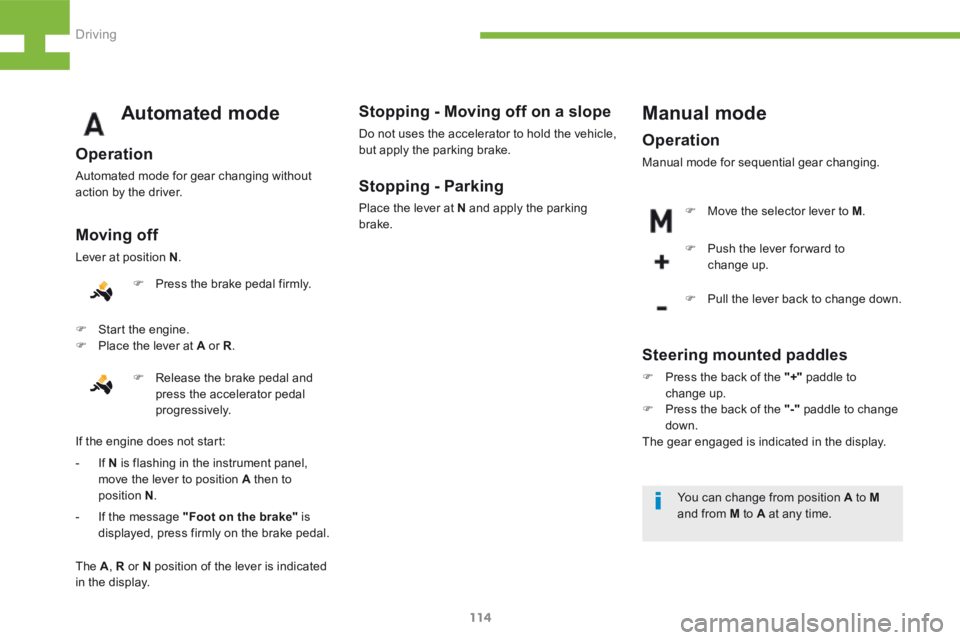
114
208_en_Chap05_conduite_ed01-2015
Stopping - Moving off on a slope
Do not uses the accelerator to hold the vehicle,
but apply the parking brake.You can change from position A to M
and from M to A at any time.
Stopping - Parking
Place the lever at N and apply the parking
brake.
Manual mode
Operation
Manual mode for sequential gear changing.F Push the lever for ward to
change up.
F Pull the lever back to change down.
F
Move the selector lever to M .
Automated mode
Operation
Automated mode for gear changing without
action by the driver.
Moving off
Lever at position N.
F Press the brake pedal firmly.
F Release the brake pedal and
press the accelerator pedal
progressively.
- If N is flashing in the instrument panel,
move the lever to position A then to
position N .
- If the message "Foot on the brake" is
displayed, press firmly on the brake pedal.
F
Start the engine.
F Place the lever at A or R .
The A , R or N position of the lever is indicated
in the display.
If the engine does not start:
Steering mounted paddles
F
Press the back of the "+" paddle to
change up.
F Press the back of the "-" paddle to change
down.
The gear engaged is indicated in the display.
Driving
Page 117 of 341
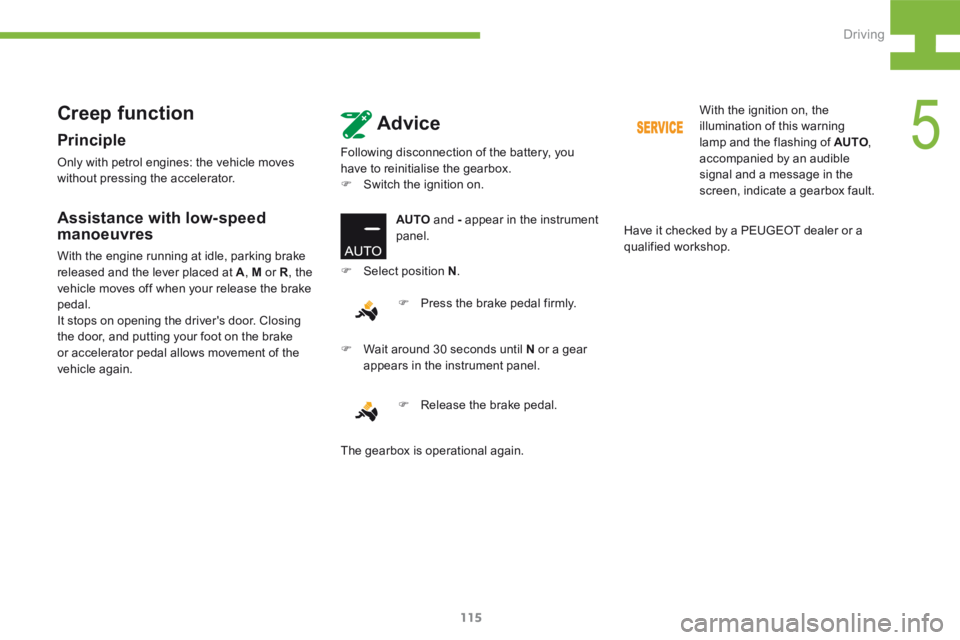
115
208_en_Chap05_conduite_ed01-2015
Creep function
Principle
Only with petrol engines: the vehicle moves
without pressing the accelerator.AUTO and - appear in the instrument
panel.
F Select position N .
F Press the brake pedal firmly.
F Release the brake pedal.
F
Wait around 30 seconds until N or a gear
appears in the instrument panel.
The gearbox is operational again. With the ignition on, the
illumination of this warning
lamp and the flashing of AUTO
,
accompanied by an audible
signal and a message in the
screen, indicate a gearbox fault.
Have it checked by a PEUGEOT dealer or a
qualified workshop.
Assistance with low-speed
manoeuvres
With the engine running at idle, parking brake
released and the lever placed at A , M or R, the
vehicle moves off when your release the brake
pedal.
It stops on opening the driver's door. Closing
the door, and putting your foot on the brake
or accelerator pedal allows movement of the
vehicle again. Following disconnection of the battery, you
have to reinitialise the gearbox.
F
Switch the ignition on.
Advice
5
Driving
Page 118 of 341
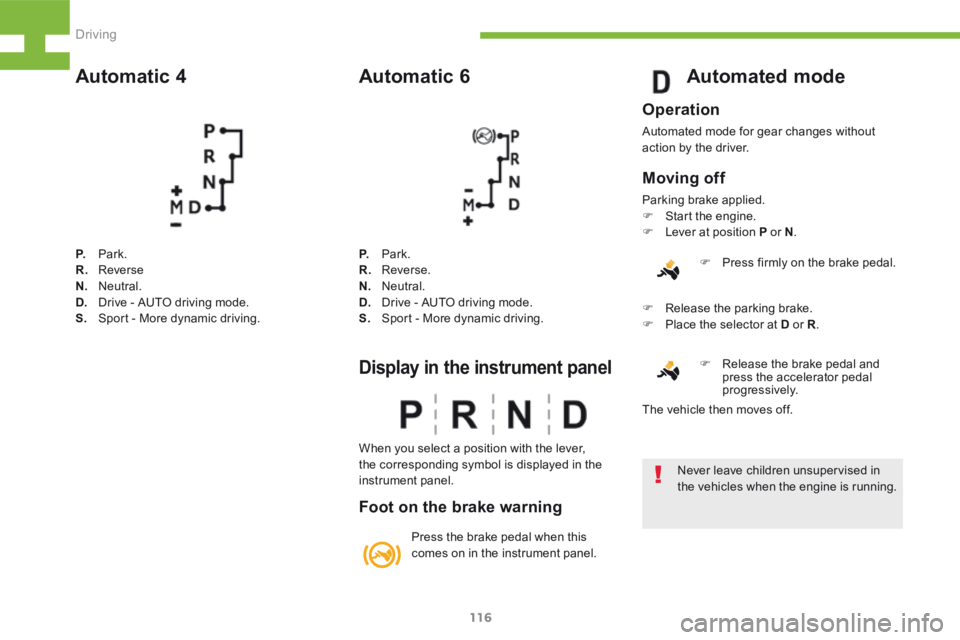
116
208_en_Chap05_conduite_ed01-2015
Automatic 4
P. Park.
R. Reverse
N. Neutral.
D. Drive - AUTO driving mode.
S. Sport - More dynamic driving.
Automatic 6
P. Park.
R. Reverse.
N. Neutral.
D. Drive - AUTO driving mode.
S. Sport - More dynamic driving.
Display in the instrument panel
Foot on the brake warning
When you select a position with the lever,
the corresponding symbol is displayed in the
instrument panel.
Press the brake pedal when this
comes on in the instrument panel.
Automated mode
Operation
Automated mode for gear changes without
action by the driver.
Moving off
Parking brake applied.
F Start the engine.
F Lever at position P or N .
F Press firmly on the brake pedal.
F Release the brake pedal and
press the accelerator pedal
progressively.
F
Release the parking brake.
F Place the selector at D or R .
The vehicle then moves off. Never leave children unsupervised in
the vehicles when the engine is running.
Driving
Page 119 of 341
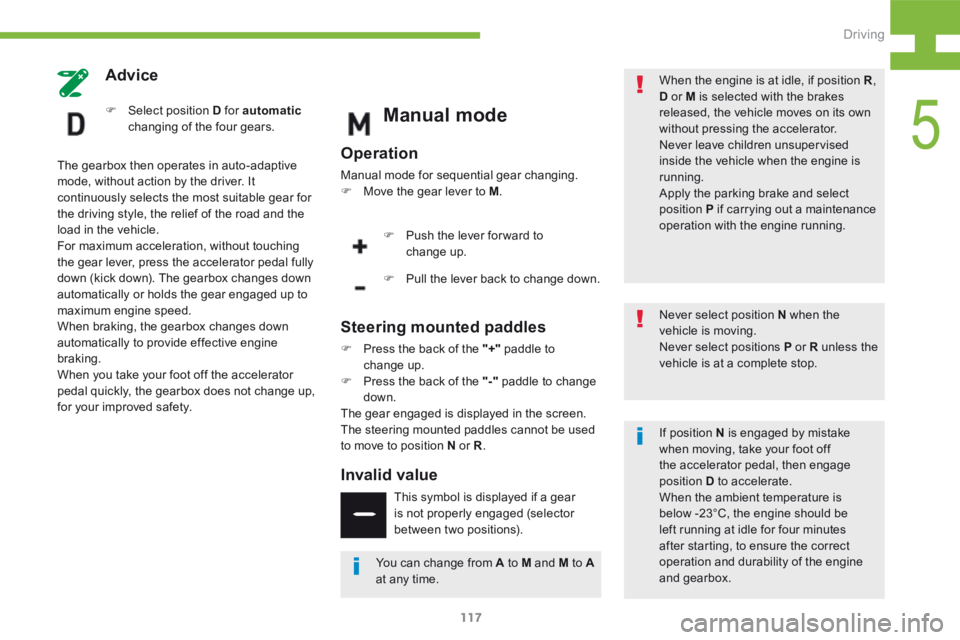
117
208_en_Chap05_conduite_ed01-2015
Advice
F Select position D for automatic
changing of the four gears.
The gearbox then operates in auto-adaptive
mode, without action by the driver. It
continuously selects the most suitable gear for
the driving style, the relief of the road and the
load in the vehicle.
For maximum acceleration, without touching
the gear lever, press the accelerator pedal fully
down (kick down). The gearbox changes down
automatically or holds the gear engaged up to
maximum engine speed.
When braking, the gearbox changes down
automatically to provide effective engine
braking.
When you take your foot off the accelerator
pedal quickly, the gearbox does not change up,
for your improved safety.Manual mode
Operation
Manual mode for sequential gear changing.
F Move the gear lever to M .
F Push the lever for ward to
change up.
F Pull the lever back to change down.
Steering mounted paddles
F Press the back of the "+" paddle to
change up.
F Press the back of the "-" paddle to change
down.
The gear engaged is displayed in the screen.
The steering mounted paddles cannot be used
to move to position N or R .
Invalid value
This symbol is displayed if a gear
is not properly engaged (selector
between two positions). When the engine is at idle, if position R
,
D or M is selected with the brakes
released, the vehicle moves on its own
without pressing the accelerator.
Never leave children unsupervised
inside the vehicle when the engine is
running.
Apply the parking brake and select
position P if carrying out a maintenance
operation with the engine running.
Never select position N when the
vehicle is moving.
Never select positions P or R unless the
vehicle is at a complete stop.
You can change from A to M and M to A
at any time. If position N is engaged by mistake
when moving, take your foot off
the accelerator pedal, then engage
position
D to accelerate.
When the ambient temperature is
below -23°C, the engine should be
left running at idle for four minutes
after starting, to ensure the correct
operation and durability of the engine
and gearbox.
5
Driving
Page 120 of 341
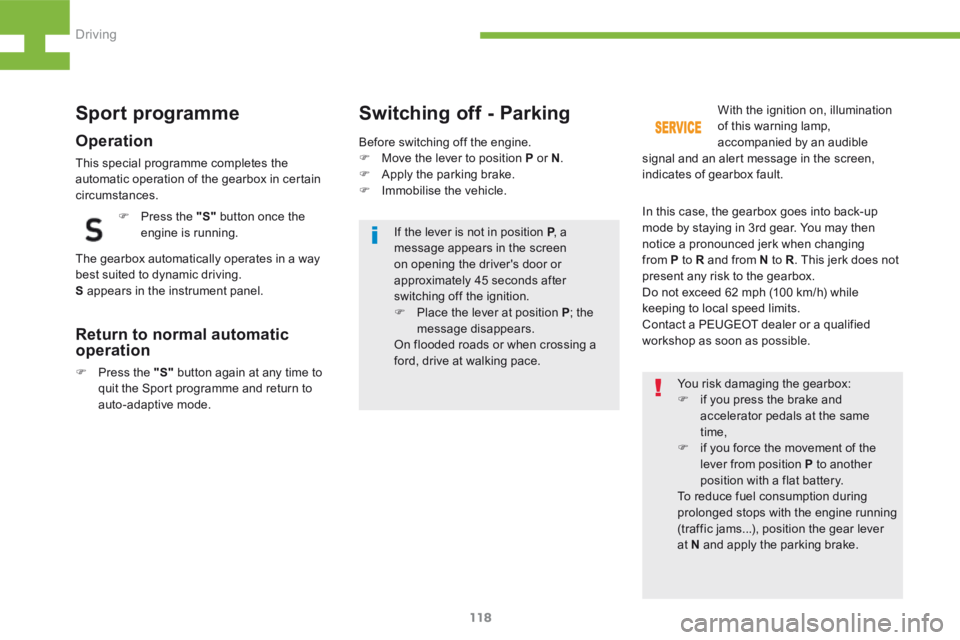
118
208_en_Chap05_conduite_ed01-2015
Sport programme
Operation
This special programme completes the
automatic operation of the gearbox in certain
circumstances.F Press the "S" button once the
engine is running.
The gearbox automatically operates in a way
best suited to dynamic driving.
S appears in the instrument panel.
Return to normal automatic
operation
F Press the "S" button again at any time to
quit the Sport programme and return to
auto-adaptive mode.
Switching off - Parking
Before switching off the engine.
F Move the lever to position P or N .
F Apply the parking brake.
F Immobilise the vehicle.
You risk damaging the gearbox:
F if you press the brake and
accelerator pedals at the same
time,
F if you force the movement of the
lever from position P to another
position with a flat battery.
To reduce fuel consumption during
prolonged stops with the engine running
(traffic jams...), position the gear lever
at N and apply the parking brake.
If the lever is not in position P
, a
message appears in the screen
on opening the driver's door or
approximately 45 seconds after
switching off the ignition.
F Place the lever at position P ; the
message disappears.
On flooded roads or when crossing a
ford, drive at walking pace. With the ignition on, illumination
of this warning lamp,
accompanied by an audible
signal and an alert message in the screen,
indicates of gearbox fault.
In this case, the gearbox goes into back-up
mode by staying in 3rd gear. You may then
notice a pronounced jerk when changing
from P to R and from N to R . This jerk does not
present any risk to the gearbox.
Do not exceed 62 mph (100 km/h) while
keeping to local speed limits.
Contact a PEUGEOT dealer or a qualified
workshop as soon as possible.
Driving
Page 124 of 341
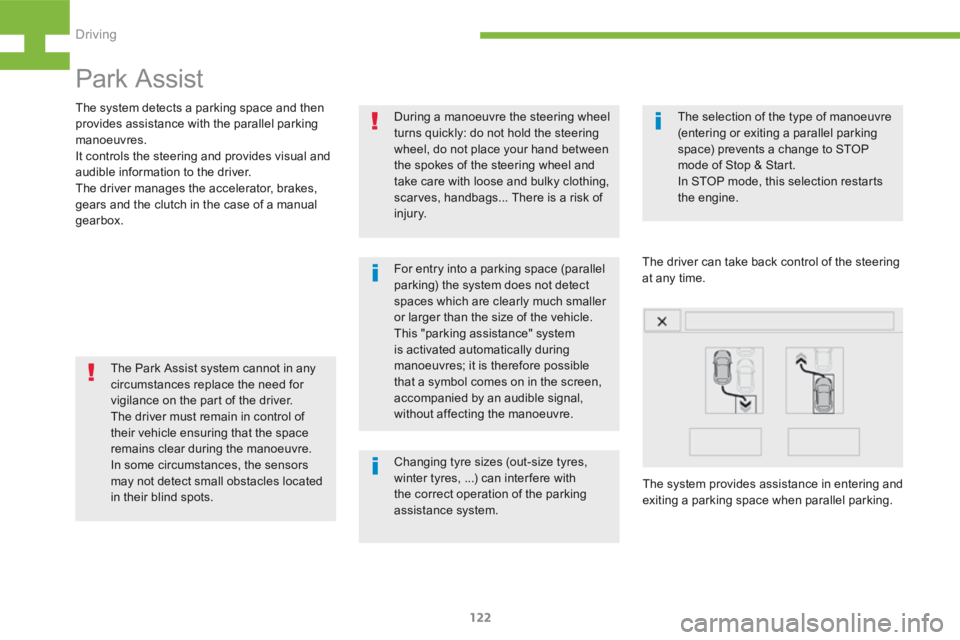
122
208_en_Chap05_conduite_ed01-2015
Park Assist
For entry into a parking space (parallel
parking) the system does not detect
spaces which are clearly much smaller
or larger than the size of the vehicle.
This "parking assistance" system
is activated automatically during
manoeuvres; it is therefore possible
that a symbol comes on in the screen,
accompanied by an audible signal,
without affecting the manoeuvre.The selection of the type of manoeuvre
(entering or exiting a parallel parking
space) prevents a change to STOP
mode of Stop & Start.
In STOP mode, this selection restarts
the engine.
The Park Assist system cannot in any
circumstances replace the need for
vigilance on the part of the driver.
The driver must remain in control of
their vehicle ensuring that the space
remains clear during the manoeuvre.
In some circumstances, the sensors
may not detect small obstacles located
in their blind spots. During a manoeuvre the steering wheel
turns quickly: do not hold the steering
wheel, do not place your hand between
the spokes of the steering wheel and
take care with loose and bulky clothing,
scarves, handbags... There is a risk of
injury.
The driver can take back control of the steering
at any time.
Changing tyre sizes (out-size tyres,
winter tyres, ...) can inter fere with
the correct operation of the parking
assistance system. The system provides assistance in entering and
exiting a parking space when parallel parking.
The system detects a parking space and then
provides assistance with the parallel parking
manoeuvres.
It controls the steering and provides visual and
audible information to the driver.
The driver manages the accelerator, brakes,
gears and the clutch in the case of a manual
gearbox.
Driving